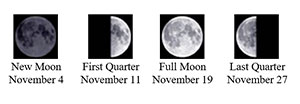Watch for Some Distant Star Clusters in the November Sky
 By Scott Levine
By Scott Levine
This time of year, change comes fast. With the leaves tangling themselves in our shoelaces, we all know that first snow is hiding just out of view.
Changes also come quickly to the nights.
As the Zombies take to the streets on their endless hunt for fresh Milk Duds this weekend, let’s take a minute in the early evening to spot one of the first signs of winter. In the east around 8 p.m., we can catch the group of stars called the Pleiades lingering above the rooftops. This early in their season, they always catch me a bit off guard, like a spider climbing a wall when you flip on the light. It’s a bit of a shock for everyone involved.

Many of us are surprised that we can see deep-sky objects – things outside our solar system other than individual stars – with the naked eye. The Pleiades is one of the nearest star clusters to us, about 450 light years away. That’s close as these things go, but far enough that the light we see now left during the Renaissance.
How many can you see? In Westchester’s skies, five or six shouldn’t cause too much trouble. Through binoculars, the view is remarkable, with hundreds of twinkling gems spilled across the night.
Then, just an hour behind the Pleiades, is another cluster: the Hyades. It’s only about a third of the Pleiades’ distance but, partly because it’s so much closer, it appears much bigger, though it has fewer stars.
I always love the sight of these two as they climb the night. The Pleiades are blue and mellow, with a casual tiny dipper-shape (though not the famous Little Dipper). Meanwhile, the Hyades’ V-shaped angles are severe and acute. As it rises, it’s almost like a greater-than sign, comparing the left side of the sky to the right.
People have marveled at this pair for as long as there have been people to marvel at them. For ages, that hour-long gap has been called the Golden Gate of the Ecliptic, named because the ecliptic – the path the solar system’s objects appear to follow across the sky – crosses between them. As time goes by, we can even see the planets busily commute in and out through the gate. Unfortunately, none are near enough to it now, but we always have the moon.
Starting in November, when these stars join the easy part of the night, our nearest neighbor crosses through the gate once each month. If you have just one night this month to look up, make it Nov. 19. We’ll see the full moon smack between the pair in a positively stunning line running toward the horizon. Then, month by month, we can keep an eye on the clusters, and see where the moon joins them. Each time, we’ll watch them move westward relative to where they were last time, until they disappear in the still-glowing April dusk, changed into springtime stars. Each time the moon moves through, they’ll be in a different place in the sky; each time in a different phase.
The pace is slow, but there are always changes happening in the skies. I hope you’ll look this month and let me know how it goes. Clear skies!
Scott Levine (astroscott@yahoo.com) is an astronomy writer and speaker from Croton-on-Hudson. He is also a member of the Westchester Amateur Astronomers, who are dedicated to astronomy outreach in our area. For information about the club including membership, newsletters, upcoming meetings and lectures at Pace University and star parties at Ward Pound Ridge Reservation, visit westchesterastronomers.org.

Examiner Media – Keeping you informed with professionally-reported local news, features, and sports coverage.
